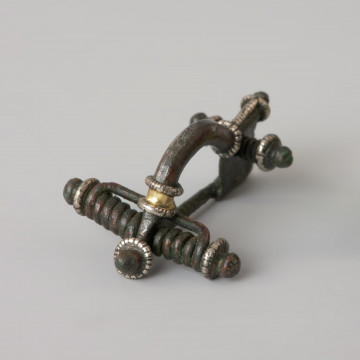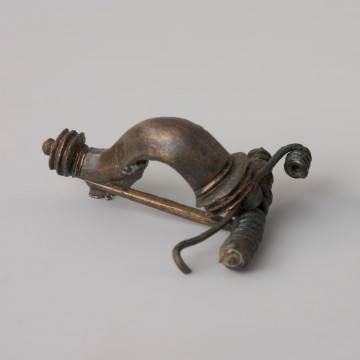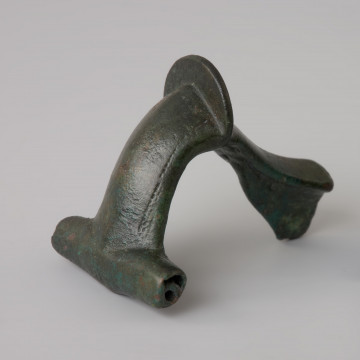
Tortoiseshell buckle
National Museum in Szczecin
Part of the collection: Antiquity
The main function of the brooches (fibulae) was to fasten the elements of clothing or to attach the neck-rings made of amber and glass beads. This group of monuments is very diverse. Fibulae can be divided into several classes depending on differences in design, decoration and the type of metal used to make them. The presented fibula is classified as the so-called trumpet fibula, due to a characteristic shape of the bow which is broader above the spring. The narrow indentation running around the edge of this broader part, the so-called head, could originally have been filled with another coloured metal. This fibula also has a rib on its bow (the so-called crest), typical for this variant, and a profiled button, which could also have been decorated with an appliqué of coloured metal. At the turn of the 1st/2nd century, trumpet fibulae were common in the areas between the Odra and Vistula rivers, where local varieties have emerged. The fibula on display was a part of the assemblage from an inhumation grave of the Wielbark culture in Karwów (Łobez poviat). This culture, which occupied the area of Western Pomerania between the 1st and the mid-5th centuries, is commonly identified with the Germanic tribes of Goths and Gepids. It derives its name from the town of Wielbark, where the characteristic handicraft products come from. This inhumation burial was discovered and excavated amateurishly in April 1881 by pastor Kuhse, a local amateur archaeologist and collector of antiquities. Besides the trumpet brooch, he also found in this grave a decorative, profiled bronze strap-end. Initially, these items remained in his private collection. Later discoveries, including another inhumation grave, probably a double one, and other cremation burials, allow assuming that there was a large cemetery of the Wielbark culture in Karwów. The societies of this culture practiced both the cremation and the inhumation burials.
Bartłomiej Rogalski
Author / creator
Dimensions
cały obiekt: height: 2.2 cm, width: 4.1 cm
Object type
pin (fastener)
Technique
casting
Material
bronze
Creation / finding place
Owner
Muzeum Narodowe w Szczecinie
Identification number
Location / status

National Museum in Szczecin

National Museum in Szczecin

National Museum in Szczecin
DISCOVER this TOPIC
Museum of King Jan III's Palace at Wilanów
DISCOVER this PATH
Educational path